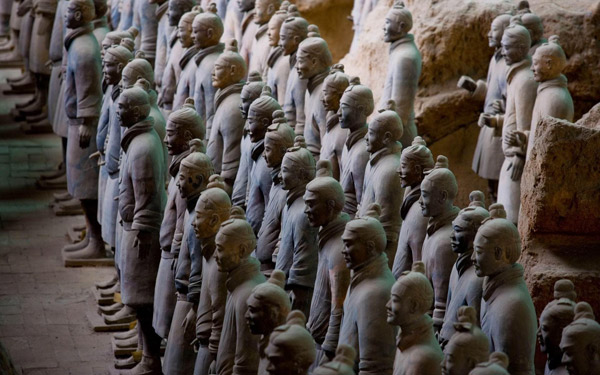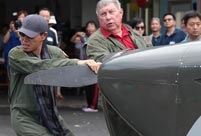


The Terracotta Warriors in the tomb of Qin Shi Huang in Xi'an, northwest China's Shaanxi province. [File photo]
Archaeologists believe that the appearance of the Terracotta Warriors in the tomb of Qin Shi Huang, the first emperor of China was inspired by ancient Greeks, the BBC reported on Tuesday.
Ancient Greeks were even thought to have directly trained local artisans of the Qin Empire (221-206 BC). The latest finding broke the theory that the first direct contact between China and the west was through Marco Polo in the 13th century.
"There is evidence that the earliest contacts between China and Europe was made before the opening of the ancient 'Silk Road'. It is much earlier than what the current record shows," said Li Xiuzhen, renowned archaeologist in the Emperor Qin Shi Huang's Mausoleum Site Museum.
The Terracotta Warriors in the tomb of Qin Shi Huang were discovered accidentally by a farmer in Lintong County, northwest China's Shannxi province in 1974.
There was no tradition of building human statues as large as what is now known as the Terracotta Army before the Qin Empire, and a more reliable explanation of the phenomenon is that it is the result of foreign influence, according to Li.
The newly found "jumping and rolling" acrobat terracotta figures in Qin Shi Huang's tomb showed different artistic styles from the others, which could be evidence of the foreign influence theory, Lukas Nickel, professor of University of Vienna noted.
 Home-made plane completes test flight in Chicago
Home-made plane completes test flight in Chicago The untold stories of women in the Long March
The untold stories of women in the Long March Female soldiers on Frigate Jingzhou
Female soldiers on Frigate Jingzhou Top 10 most beautiful Chinese athletes in Rio
Top 10 most beautiful Chinese athletes in Rio Shenzhen seizes 549 tons of illegally smuggled clothing
Shenzhen seizes 549 tons of illegally smuggled clothing Chinese actor Wang Baoqiang divorces wife, fires manager
Chinese actor Wang Baoqiang divorces wife, fires manager Hangzhou: host city of G20 Summit
Hangzhou: host city of G20 Summit New hovercrafts debut in landing exercise
New hovercrafts debut in landing exercise Woman sets Guinness World Record with 17-month-long pregnancy
Woman sets Guinness World Record with 17-month-long pregnancy Top 10 livable Chinese cities
Top 10 livable Chinese cities Top 20 hottest women in the world in 2014
Top 20 hottest women in the world in 2014 Top 10 hardest languages to learn
Top 10 hardest languages to learn China’s Top 10 Unique Bridges, Highways and Roads
China’s Top 10 Unique Bridges, Highways and Roads Trading sex for travel
Trading sex for travel ‘Voice of China’ helps pave way for Xinjiang music talent
‘Voice of China’ helps pave way for Xinjiang music talent Beijing car-sharers feel driven out
Beijing car-sharers feel driven out Google’s Neural Machine Translation sparks debate over the future of AI
Google’s Neural Machine Translation sparks debate over the future of AIDay|Week